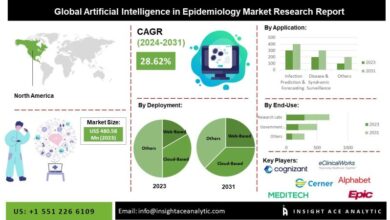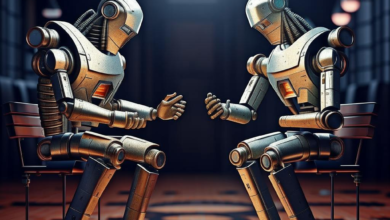AI’s employment impact: 86% of workers fear job losses, but here’s some good news

This is the year when artificial intelligence (AI) moves from the margins to the mainstream. While some companies have been using AI and machine-learning technologies to boost operational performance for several years, fewer organizations have found ways to put generative AI tools, such as ChatGPT and Microsoft Copilot, into production.
Also: Agile development can unlock the power of generative AI – here’s how
You can expect that trend to change this year as more organizations explore and exploit generative AI, said David Brodeur-Johnson, principal analyst at Forrester, to ZDNET.
“2024 will be the year that firms get serious about applying generative AI to their internal data sources and making information and insights available to their employees to help them do their jobs even better.”
Research shows AI spending in 2024 will more than double over levels seen in 2023, equating to an average of $2.5 million per company, according to a survey by Rackspace Technology and Amazon Web Services.
Also: Generative AI is the technology that IT feels most pressure to exploit
But while employers are looking to introduce automation, many employees are concerned that increased use of technologies like generative AI is far from good news.
Forrester’s research suggests as many as 86% of US employees fear that many people will lose their jobs to AI and automation, and almost a third (31%) believe that trend will manifest during the next two to five years.
Digital leaders responding to a global survey from recruiter Nash Squared come to similar conclusions, with 17% being the average percentage of jobs digital leaders feel will be lost to automation.
Yet context is important. While there’s an understandable focus on the fear many roles could be automated away, there’s less analysis of how AI could boost worker efficiency and productivity and increase economic activity and growth.
Debra Bonomi, head of learning and development at e-commerce giant Rakuten, has initiated a program with ELB Learning at her organization to help staff upskill for the upsurge in AI — and she said employees in all areas of business must embrace change.
“This isn’t something to be afraid of,” she told ZDNET. “The only thing we should be afraid of is if we continue to be the person who says, ‘Oh, I don’t need it. It’s not going to impact me.’ Those are the people whose jobs will be impacted negatively.”
Also: Generative AI can transform customer experiences. But only if you focus on other areas first
Bonomi said her organization is committed to exploring the benefits of AI. The company has partnered with OpenAI to create an internal version of ChatGPT, and Rakuten employees can already see benefits.
“It’s not only going to make us more efficient, but it’s going to change our jobs,” she said. “Not everyone will lose their jobs, but we may be doing very different tasks, roles, and responsibilities in the future. There’s nothing to fear, as long as we’re okay with that change and we keep adapting along the way.”
That sentiment resonates with Bev White, CEO at recruiter Nash Squared, who told ZDNET it’s important not to jump to conclusions just yet despite the likelihood that AI will lead to big changes in the job market.
She said the story of the introduction of automation — from the Industrial Revolution to our present digital age — has always revolved around fears that jobs will be cut.
While AI and automation will lead to the end of some roles, the tools should also help change many workplaces and work roles for the better.
Also: 4 ways to help your organization overcome AI inertia
White refers to software development and quotes research that suggests developers who use GitHub Copilot complete tasks 55% faster than developers who don’t.
The same research found between 60% and 75% of developers report that using generative AI tools as part of their roles leaves them feeling more fulfilled, less frustrated when coding, and able to focus on more satisfying work.
“Emerging technology is speeding things up,” said White. “It’s taking human processes out — which are repetitive, and not necessarily interesting for a human being to do — and replacing them with automated ways of doing things faster.”
Even with increased levels of automation, companies will still need a human in the loop to ensure processes are completed effectively, such as dealing with more complicated customer service requests.
White said the tactical deployment of AI and automation should mean professionals will have an increased opportunity to focus on crucial business areas.
“People will be able to do things, not only faster, but more cheaply and spend more time on the human elements — the thinking time, the decision-making time — that are essential to value-added processes.”
Nigel Richardson, SVP & CIO Europe at PepsiCo, is another business leader who said AI will boost worker efficiency and productivity.
“Generative AI will be a huge augmenter to people’s work rather than fully replacing it,” he said.
“Of course, some elements of jobs will get replaced. But I think history shows that when you’ve got disruptive technologies, they usually create more jobs than they destroy.”
Also: 5 ways CIOs can manage the business demand for generative AI
Richardson said to ZDNET that the professionals who will benefit from the rise of AI are likely to be those who embrace change.
“You need to have a mindset of being a lifelong learner,” he said. “The people I see being successful are always open to learning new things. You’re mistaken if you learn one thing and think it will last you for your career.”
The key message from business leaders is that professionals must shift their feelings on AI from dread to confidence.
Ben Elms, chief revenue officer at internet connectivity specialist Expereo, told ZDNET that almost every technological innovation implementation comes with a side order of fear.
“If you approach AI as, ‘It’s going to change the world, and it’s going to put people out of jobs,’ well, it isn’t — it’s going to create even more opportunity and jobs,” he said.
Elms said the key to success is finding the right use cases. He gave an example from his own company, which is based on resolving customer service requests, many of which require a standard answer.
“These are highly repeatable tasks,” he said. “These requests are text-based and many of the answers can be served effectively by AI quickly. That capability means people can come out of the service function, I can give them more training, and they can be frontline people, enhancing the customer experience.”
Also: 5 ways to prepare for the impact of generative AI on the IT profession
Hari Ramamurthy, technology fellow at The Home Depot, is another business leader who said AI and automation can help workers focus on more interesting work.
“We definitely see it as something that will improve the productivity of our associates and help them with the laborious, monotonous aspects of what they’re working on.”
Ramamurthy recently explained to me how the retail giant has developed a machine learning-powered app called Sidekick to boost staff productivity.
The app, which also uses computer vision, helps shopfloor staff identify items in hard-to-find locations.
“It was painful to try and search for some of our products overhead. Sometimes, an item is not exactly where you expect it to be,” he said.
“But technologies like computer vision help staff locate those products easier. And it’s that sort of mindset that we have in terms of how we can augment the capabilities of our associates by improving their productivity so we can serve the customers better.”
A recent research report by Goldman Sachs suggests the average increase in productivity from companies that have been early to adopt generative AI is about 25%.
These AI-enabled boosts could offer staff at public-facing organizations a way to cut the drudgery of repetitive work and focus on potentially life-changing activities.
Also: Want to be a data scientist? Do these 4 things, according to business leaders
Michelle Smith, program manager at Barnardo’s, a UK charity that supports more than 370,000 children, young people, parents, and caregivers, said the smart use of AI could help people focus on the frontline services that matter most.
“Relationships keep us running,” she told ZDNET. “It’s where people get the most joy from work and it’s what motivates people. We work for a purpose. If you’re stuck in front of a screen too much, and not interacting with your colleagues, it becomes painful.”
Smith said generative AI tools could help the charity to cut the administrative bind and give people more time to think, collaborate, and make decisions.
“I’ve worked in operational roles for years and there’s loads of things where I think, ‘Oh, I’d rather be speaking to a person than the tedious process of checking paperwork,'” she said.
“It would be great if we could get people freed up from processes and allow them to be creative in their roles by taking advantage of emerging technology. I’m keen for my colleagues who are still in operational roles to be given the opportunity to develop new skills.”



